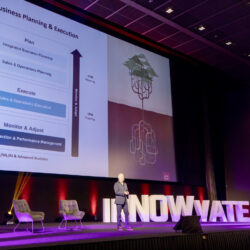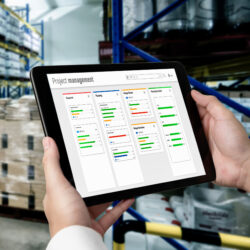Scrum or waterfall: what’s best for your organization?
Digital planning is high on the agenda for many IT and supply chain directors. They often ask themselves ‘What’s the next step?’, ‘Which tooling should we use?’ and ‘How should we tackle the implementation?’ – and they usually consider those questions in that order. I would like to suggest reversing the order of the questions. First ask yourself which implementation approach is the best fit with your organization, and then look at which tooling is needed. Roughly speaking, there are two methods for approaching an implementation: waterfall and scrum. Let’s take a closer look at these two approaches in the context of implementing a new digital planning tool.
In the waterfall method, you are expected to have a blueprint for the future supply and demand planning. You then use this blueprint to determine the necessary planning functionalities, to develop the project plan and to set the budget. Typically, these kinds of implementations usually have a long lead time and are time-consuming for key users, with lots of configuration and testing in the run up to going live.
This approach requires a high degree of stability and conceptual thinking within the organization; the project team members must already have a clear vision of how new planning concepts can be applied to the future planning approach in practice, and the design decisions may not become outdated halfway through the process due to new insights.
Scrum
The scrum method is more iterative when it comes to delivering the planning functionalities. The team works in a series of sprints lasting several weeks, each with its own target. It is perfectly feasible to go live with new and different planning functionalities at any time during the process. As a result, the project benefits from user feedback early on and adjustments can be made quickly to respond to new insights or changes in the external environment.
This approach places high demands on the methodology, but gives the project team and the senior management more freedom to set the priorities for the planning functionalities as they go along. The tool evolves gradually, keeping pace with the professional maturity and the new needs of the planning organization itself. This reduces the risk of a failed implementation.
Not all tools are suitable
Generally speaking, each of these two implementation methods calls for different types of tools. In the case of the ‘waterfall’ planning tools, there is usually a template of standard solutions that supply chain planning can benefit from. The relevant functionalities can be configured for set-up and use. However, this often requires a lengthy configuration process before the solution can actually go live.
The ‘scrum’ planning tools commonly make use of a toolbox of (low-coding) techniques to quickly develop the desired functionality. These tools incorporate fewer learnings from industry best practices or standard solutions, but they offer a lot of flexibility to rapidly start using – and to keep adapting – the functionality.
What’s best for you?
It is wise to first stop and think about what is the best fit with your own organization. If your organization is stable, with lots of highly qualified people and consensus on the desired way of working, then the waterfall method and tooling is probably best for you. But if your environment is dynamic, if there is still a lack of clarity about the future planning approach and if your organization has a history of failed implementations, then there is no doubt that the scrum method and tooling is a better fit.
This decision determines which vendors and tools should make it onto the shortlist.
Dennis Pronk, senior supply chain consultant at Involvation









